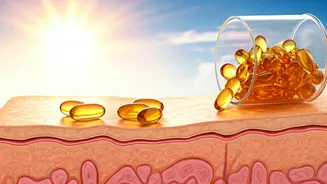Cultural Clothing Choices
Certain cultural and religious practices influence clothing styles, sometimes leading to full-body coverings. When the majority of the skin is concealed,
especially in sunlight, it significantly reduces the skin's capacity to absorb UVB rays, which are necessary for Vitamin D production. This is because these rays cannot reach the skin as effectively, which can limit the amount of Vitamin D your body can naturally create. Therefore, it is important to be aware of how these practices affect sun exposure and the potential implications for Vitamin D levels.
Modern Indoor Lifestyles
Modern living often keeps people indoors, regardless of how sunny their environment may be. Many individuals spend a significant amount of time in offices, schools, and air-conditioned environments. This can substantially restrict exposure to direct sunlight during the most effective hours for Vitamin D synthesis. This indoor lifestyle trend presents a challenge to adequate Vitamin D production, as it contrasts with the body's need for exposure to sunlight for its natural production.
Sunscreen and Vitamin D
While sunscreen is essential for protecting the skin from harmful UV rays, it has a dual effect on Vitamin D production. The same UVB rays that sunscreen blocks are vital for your skin to produce Vitamin D. High-SPF sunscreens, and even regular use, can dramatically reduce the skin's ability to synthesize this vitamin naturally. So, while protecting against sun damage is crucial, one must also be mindful of the impact of sunscreen on Vitamin D levels.
Pollution and Environment
Air pollution has a significant impact on Vitamin D synthesis, absorbing and scattering UVB rays before they reach the ground. Urban residents, who are often exposed to higher levels of pollution, might face reduced Vitamin D production even in cities with ample sunshine. This environmental factor underlines the complexity of maintaining adequate Vitamin D levels and demonstrates how external elements can interfere with its natural production.
Skin Tone and Melanin
Skin pigmentation plays a crucial role in how the body produces Vitamin D. Darker skin tones have more melanin, a natural pigment that acts as a protective barrier against UV rays. While this protection helps prevent skin damage, it also means that individuals with darker skin require significantly more sun exposure to produce the same amount of Vitamin D as those with lighter skin. This highlights the importance of personalized approaches to Vitamin D management, tailored to individual skin types.
Dietary Intake Deficiencies
Sunlight isn’t the only way to obtain Vitamin D; a balanced diet rich in the nutrient is equally important. Many individuals do not consume enough Vitamin D-rich foods, such as fatty fish, fortified milk, and egg yolks, which leads to deficiencies even when there is sufficient sun exposure. This underscores the need for a well-rounded approach to Vitamin D management that includes both sun exposure and a diet to provide adequate intake.














